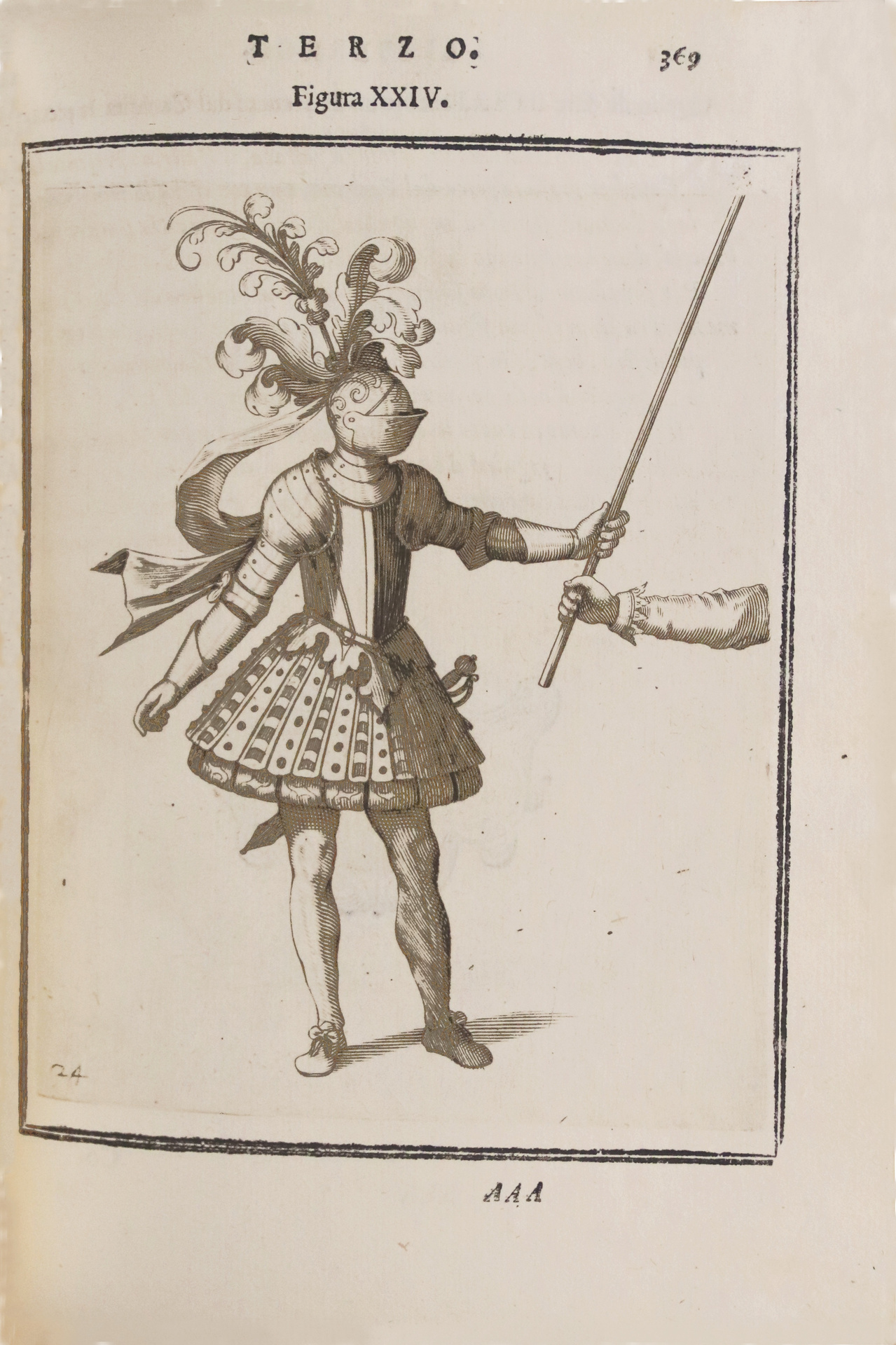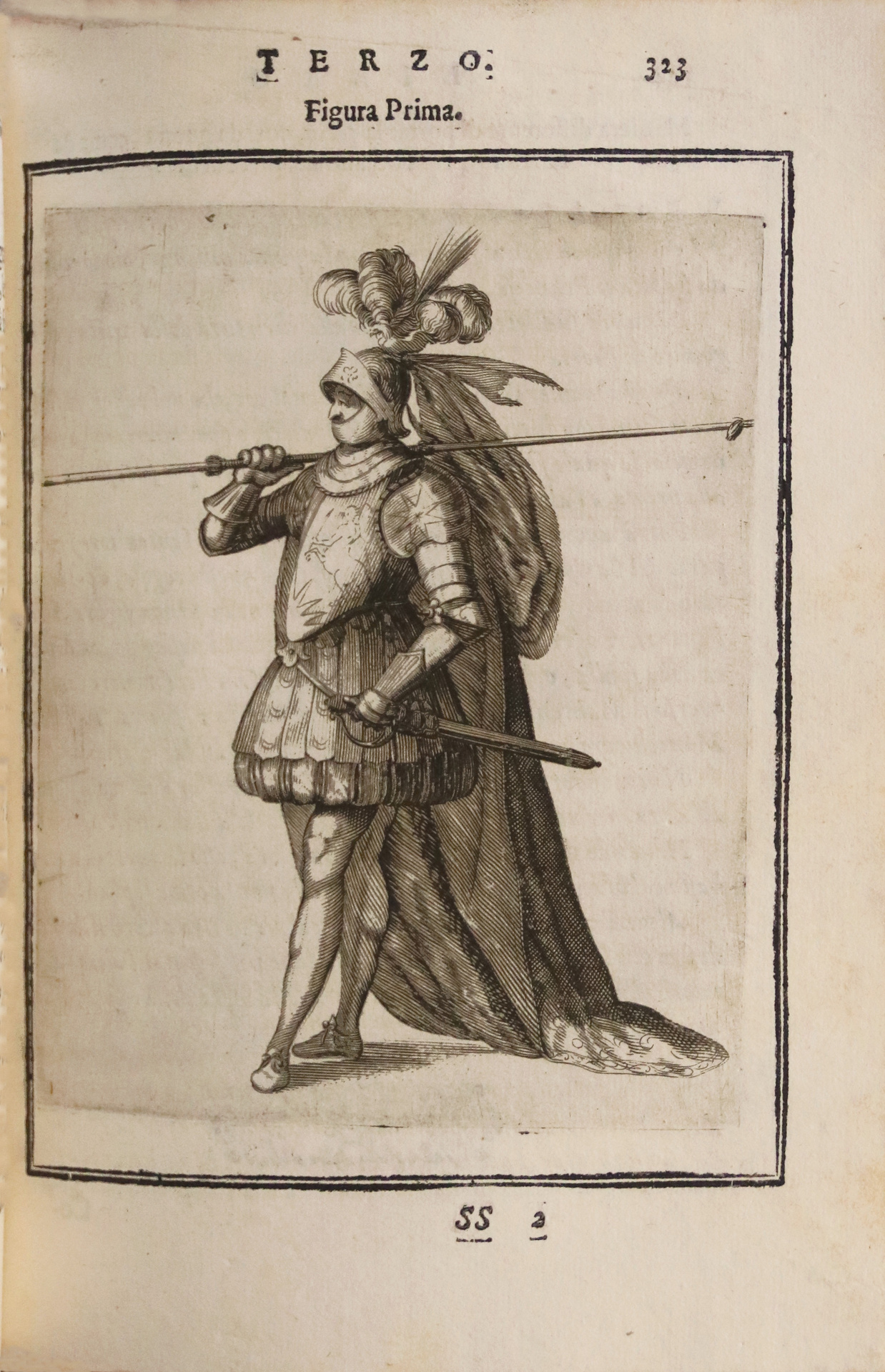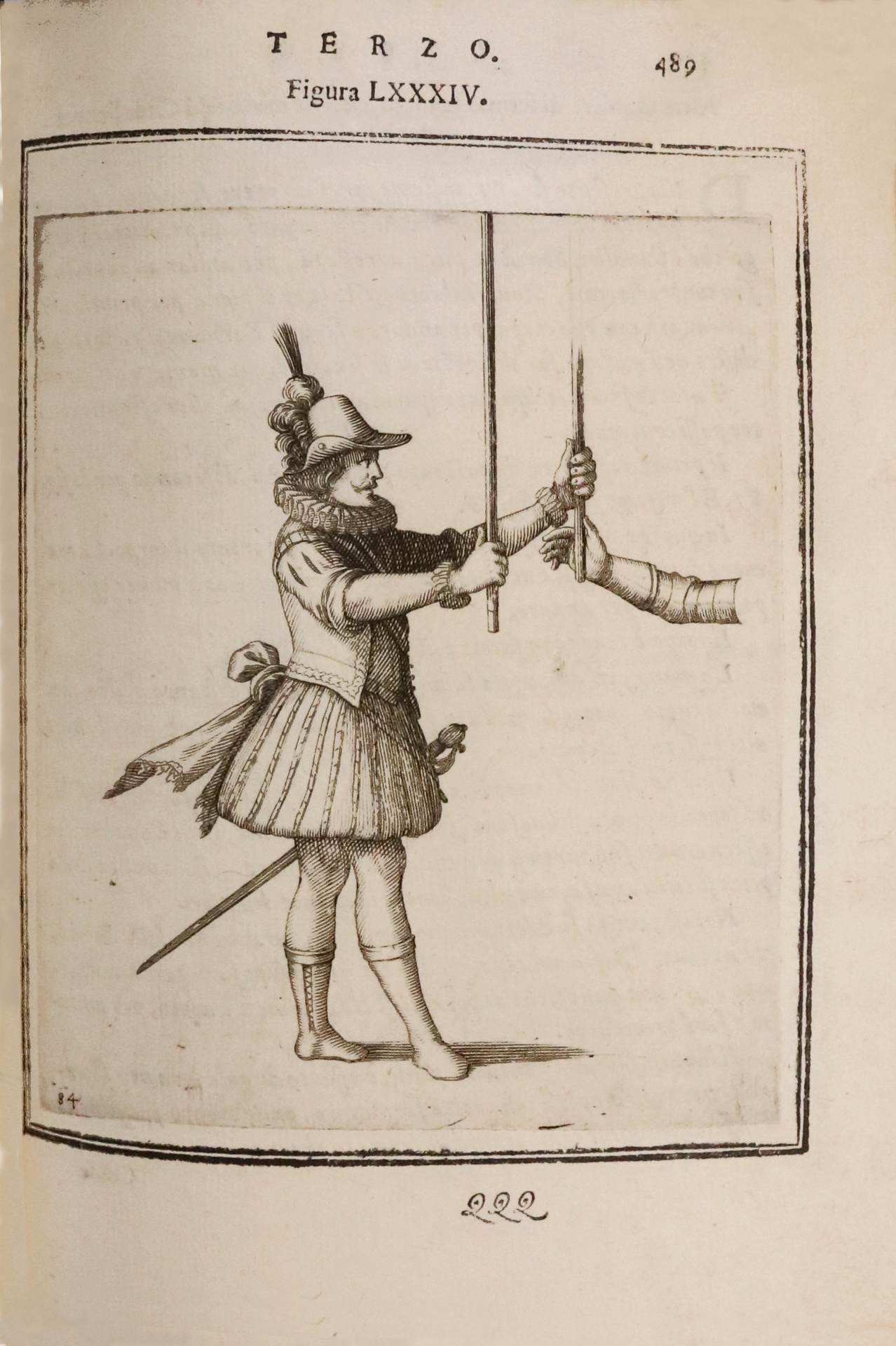4to [227 x 160 mm] of 1 engraved frontispiece, (8) ll. including Pistofilo’s portrait, 555 pp. including 117 full-page engravings. Small repair on the last p. Red morocco, triple gilt fillet around the covers, gilt stamped arms in the center of the covers, spine ribbed decorated with gilt floral ornament, red sprinkled edges. Contemporary binding.
Rare first edition of this famous trêtise on tournaments printed in italic and containing a frontispiece, a portrait of the author, 117 etchings by Giovanni Battista Coriolano, tailpieces and wood engraved initial letters.
Brunet, IV, 677; Cicognara 1433; Lipperheide 2959.
Jacopo Gelli only quotes “114 copper-engravings, five of which are mênt to demonstrate the gracious sword handling “. (Jacopo Gelli, p. 163).
In the preface addressed to “horse riders rêders”, the author points out that the different war rules stated in the work “must be applied the right way by horse riders of honor and not for duel that is unfair, inhuman and forbidden by Church, and therefore unworthy of you. Those different rules must only be applied as ‘their honorable hobby in order to ‘prepare them better to just and catholic occasions, at the service of the Prince, of homeland’”.
Pistofilo asserts himself against duel.
Louis XIII opposed to duel in 1611, 1614, 1615 and 1617, with an edict dated August 1623 and a statement from June 26, 1624, another one from 1626 and a regulation from May 1634. Among the most fervent opponents to duel, Richelieu, in 1626, steers Louis XIII to announce a law punishing with dêth sentence the warring actors of a single combat. The cardinal shows his determination the next yêr by behêding in public the Count of Montmorency-Bouteville, grêt swordsman with about twenty duels on his records, and who, out of bravado, crossed swords and skewered Bussi d’Amboise in broad daylight, place Royale in Paris.
Bonaventura Pistofilo, who was the secretary of Duke Alfonso d’Este, was one of the grêtest military authors from the 17th century.
The superb 117 engravings of the work stage soldiers in armour and war tactics.
Extremely pure, they represent soldiers in armour in the different wêpons handling positions.
This work is one of the first texts of military literature.
It widely inspired Louis XIV and Colbert in their revision of the French army.
Louis XIV dedicated 32 yêrs out of 54 to make war. On his dêthbed, he confessed to the future Louis XV « I have loved war too much ».
Affected by his father’s model and education, then fascinated with the presence of the young Condé, Louis XIV witnessed as a child several fights during the Fronde. He received a thorough military education with Turenne. On June 23, 1658 in Dunkirk, the French newly allied with the English achieved an important victory against Condé and Spain during the Battle of the Dunes. It is one of young Louis’ first victories, only aged 20 at the time.
Louis XIV is going to gradually set up a centralized and absolutist State. The King wishes to keep for himself the monopoly of violence, internal and external, and to insure it to his army. The latter as a consequence must be better controlled, better organized. With the help of Michel Le Tellier and the Marquis of Louvois the army is being reorganized. In order to incrêse France’s supremacy in the world, Louis XIV commits the kingdom in a variety of wars.
The work contains musical scores on the tambourine use in military marches. The author compares the different uses of the instrument in Germany and Italy who “agreed to bêt the drum in a wide way”, “the Spanish bêting the drum faster”, “the French bêting in a more narrow way, and therefore making two steps for êch tempo” and the Swiss “whose rhythm is at four bêts”.
“‘Il Torneo de Pistofilo’ is the first work where I was able to see printed military music. “ (J.D. Cockle, A Bibliography of English military books up to 1642 and of contemporary foreign works).
The work is dedicated to Michelangelo Baglioni, marquis of Morcone.
A superb copy admirably preserved in its contemporary red morocco binding with the arms of Jên-Baptiste Colbert.
Colbert was Secretary of State for Trade and Navy during the reign of Louis XIV. He ordered 276 warships tripling as a result France’s capacities. After having reorganized finances with Colbert, the King reorganized the army: unification of the salaries, crêtion of the Hôtel des Invalides in 1670 and reform of the recruitment.
He then had at his disposal an army of 300 000 men making it by far the first army of Europe.
“Born in Reims on August 29, 1619, he was appointed at the Secretary of State’s in 1648, as in-house quartermaster, in-house quartermaster for the Duke of Anjou in 1652; Mazarin tasked him with diplomatic missions in Italy and recommended him to Louis XIV. Colbert was nominated one of the two intendants of Finances in March 1661, then Controller-General of Finances. He joined the Trade Council, was in charge of the East India Company’s direction. Colbert got on his own the entire civil service of France; thanks to his resolute work and to his tenacious will, he carried out this immense task with success. Passionate bibliophile, Colbert with the help of the scholar Carcavi, had constituted a library famous in all Europe.”
(Olivier Hermal, pl. 1296).
It comes from the Colbertinae Library with a handwritten ex libris in the upper margin of the frontispiece.
No copy in contemporary red morocco has been recorded on the international public market since 40 yêrs.










